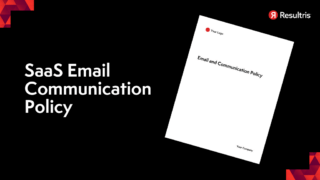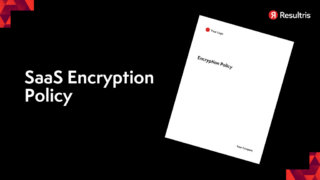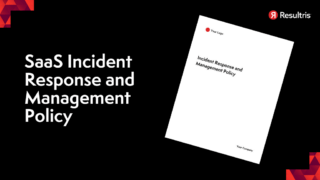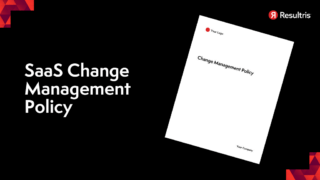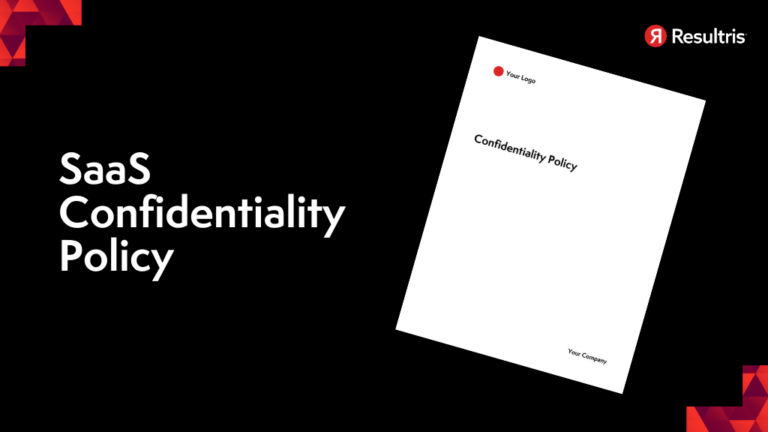
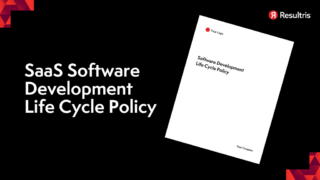
Written by: Tim Eisenhauer
Last updated:

In the world of digital business, there’s no room for compromise when it comes to data privacy and security. That’s where a SaaS Confidentiality Policy comes into play. It’s like a guardian angel, protecting your business from potential threats and legal pitfalls.
Understanding the ins and outs of this policy isn’t just a good-to-know, it’s vital for any business using SaaS solutions. It’s also crucial to be aware of the SaaS Compliance and Security Best Practices to further fortify your business.
The process of understanding SaaS confidentiality policies is fundamental to every business owner, especially those relying on SaaS solutions.
A SaaS Confidentiality policy acts as a legal buffer in your business. This critically forged document sets out specific rules about sharing, using, and protecting company information. It’s the embodiment of a corporation’s commitment to secure every piece of data belonging to the firm and its clients. The primary purpose of this policy is to ensure data integrity, limit data access, and protect sensitive information.
Fundamentally, confidentiality in SaaS encompasses user data, transactional data, and all other information processed through the service. Precisely, data in use, at rest, and in transit are all within its scope. Thus, it implies as a business, you’re legally bound to safeguard data from security breaches, misuse, unlawful processing, and unauthorized disclosure.
Confidentiality policies shield a company’s intellectual property (examples include patents, trade secrets, brand logos). By declaring the boundaries of data handling, such policies prevent unwarranted exploitation or revelation of intellectual assets, fortifying corporate identity and competitiveness.
Trust forms the backbone of every client relationship. By enacting strong confidentiality practices, you signal to your customers that their critical data is in safe hands. This, in turn, fosters faith, amplifies satisfaction, and assures loyalty.
Lastly, embedding a confidentiality policy in your business model harmonizes with the legal and regulatory landscape. Since various jurisdictions mandate data protection regulations (like GDPR in the EU and CCPA in California), having a robust policy in place not only courts compliance but also steers clear of hefty fines and reputational damage.
You’ve already busted the myth that confidentiality policies are just ink on paper. Now it’s time to get up close and personal with the core components that constitute a robust SaaS Confidentiality Policy. You will delve into types of confidential information, access control measures, the role of NDAs, and prudent data handling procedures.
Let’s start with identifying what data you’re protecting. It’s not just about customer information; other forms of classified information need safeguarding too.
Primarily, your customer’s data serves as confidential information. This extends from personal details like name and email addresses, to more sensitive info such as banking details – all of which need strict protection.
Your proprietary technology – the cornerstone of your operational efficiency – falls under confidential information. This includes patented algorithms and bespoke software developed internally.
Operational blueprints, expansion plans, or internal business strategies all constitute confidential information. These strategic documents, if disclosed, can leave your business exposed to competitors.
Your workforce is the beating heart of your organization. Hence, employee information, from email addresses to payroll details, represents another facet of confidential data you must guard well.
When it comes to safeguarding your classified information, implementing stringent access control policies and information categorization can be effective defenses.
Non-disclosure agreements, or NDAs, serve as your front line defense in maintaining confidentiality. They encourage honesty while also providing a legal framework for potential recourse in the event of a witching breach.
Finally, you’ll need efficient data handling procedures – hopping from storage, usage, to eventual disposal. A defined data lifecycle approach helps preserve data integrity and its confidentiality. Remember, it’s about creating a secure ecosystem, not just a secure storage vault.
Managing confidentiality in a SaaS environment involves various stakeholders. Each of these participants has a distinct set of responsibilities that contributes to the integrity and security of the entire system.
Executive leaders hold the highest responsibility in the development and maintenance of a SaaS Confidentiality Policy. Aiming for robust data protection, they guide the strategic direction of security. They consistently enforce regulations that safeguard sensitive information and ensure all business operations adhere to strict confidentiality measures. For instance, an executive might spearhead an initiative to subject all third-party vendors to stringent security assessments as a requirement for partnership.
Not just the management, but every employee has a role to play. Staff members carry significant responsibility in safeguarding sensitive data due to their constant interaction with it. They’re usually required to sign NDAs as a component of their employment agreement. Additionally, they’re given regularly updated training on secure data handling and the repercussions of mishandling company or client data.
The involvement of third-party vendors in a SaaS-driven business demands extra attention. It’s—you guessed it—entirely your responsibility to regulate their interaction with your system. This regulation involves outlining the vendors’ roles and responsibilities in any contracts signed. For example, a clause pointing out the consequences of privacy breaches, and the mandatory use of encrypted channels when accessing customer data.
Customers, on their end, have a few obligations too. While your company does the heavy lifting in terms of security, they’re responsible for managing their own account credentials and personal information. They should also comply with any confidentiality terms outlined in your service agreement, like not sharing their login details or attempting to reverse-engineer your software.
In the pursuit of a sound Confidentiality Policy for your SaaS business, forging practical and pragmatic strategies for data conservation matters significantly.
Understanding, it’s vital to unearth the unique confidentiality necessities that apply for your SaaS initiative. Start by identifying specific types of data your business gathers, such as customer records or proprietary software. Then, analyze potential vulnerabilities that may lead to unauthorized exposure of this secret information. By doing so, you can carve out designation of ‘what is confidential’ specifically catering to your SaaS business.
For superior clarity and zero ambiguity, it’s crucial to outline various confidentiality levels. Classify data into different categories. For instance, customer data could be of higher confidentiality level due to its sensitivity, over general business data. Listing out these data classes with detailed definitions serves to disseminate a crisp comprehension of their associated importance and secrecy quotient.
With the confidentiality grade set, it’s paramount to devise a sturdy protocol for data dissemination. Lay out distinct rules about how, when, and who can access the sorted data classes. For instance, if the type of data is sensitive financial data, create protocols that majorly restrict its access to top-tier management exclusively. Doing this ensures a strong data containment cushion avoiding any needless data leaks.
Finally, don’t forget to instill robust security measures that stick to your defined confidentiality levels. This could take form in comprehensive employee training on data handling, stringent access controls, and the utilization of state-of-the-art cybersecurity technologies. A swift instance to paint the importance: For top-level confidential data, multi-factor authorization or biometric system-based access could be implemented. Such drastic actions are not just lofty standards but real-world practices that fortify your SaaS confidentiality policy. Remember, you’re only as strong as your weakest link.
In the quest for robust data protection within a SaaS operation, it’s all about embedding confidentiality in your standard operating procedures. Below are tactics to safeguard data with a layered approach.
Educating your workforce sits at the crux of maintaining confidentiality. Implement comprehensive training programs, focusing on data privacy regulations, ethical handling of data, and the appropriate use of software platforms. Additionally, scheduling regular updates on new threats boosts the company’s cyber hygiene. For example, phishing schemes continually evolve, so information on their current form enables employees to spot them. Hence, a well-informed team is your first line of defense against data breaches.
Don’t let your guard down after setting up comprehensive security systems and protocols. Regular security audits are paramount in ensuring that your preventive measures aren’t obsolete in the face of emerging cyber threats. For instance, annual penetration testing can reveal vulnerabilities in your system which, if left unattended, could be exploited by cyber criminals. Regular audits help in reassessing the risks and refining your security measures accordingly.
Wishful thinking can’t guarantee lifetime protection from data breaches. Prepare for the worst-case scenario with a robust Incident Response Plan (IRP). It outlines the steps to be taken immediately following a data breach, with goals like identifying the breached data, isolating the affected part of the system, and notifying affected entities. For example, General Data Protection Regulation (GDPR) mandates that individuals affected by data breaches be informed within 72 hours. Having an IRP ensures swift action is taken, limiting potential damage.
Preventing external data breaches is crucial, but don’t overlook potential internal leaks. Use secure communication channels, especially when transmitting sensitive information. For example, using End-to-End Encrypted (E2EE) platforms such as Signal for inter-departmental communication minimizes the risk of data leaks. Additionally, enforcing password protection on all devices and restricting access to confidential files based on the need-to-know principle can make a world of difference in maintaining confidentiality.
Navigating the labyrinth of legal and regulatory considerations is vital in SaaS. Grasping the gravity of global data protection laws and weaving these understandings into your Confidentiality Policy bolsters a SaaS operation’s reliability and consumers’ trust. This section breaks down key legal and regulatory aspects of GDPR, industry-specific regulations, and intellectual property protection for you to consider.
Underpinning every SaaS operation, the General Data Protection Regulation (GDPR) outlines how you can pseudonymize and secure personal data of EU citizens effectively. It mandates strict penalties for violations. Heads-up, it isn’t solely EU-focused; if your firm handles EU citizens’ data, regardless of your geographical location, GDPR applies to you. Failing to comply? Brace yourself for fines up to €20 million or 4% of your firm’s global annual turnover of the previous financial year, whichever’s higher. GDPR compliance not only encourages customer trust but also shields your business from debilitating fines and reputational harm.
Your business niche could require adherence to additional industry-specific regulations. If you’re in healthcare, the Health Insurance Portability and Accountability Act (HIPAA) monitors how you handle and protect patient data. Similarly, the Payment Card Industry Data Security Standard (PCI DSS) oversees businesses handling cardholder data. Understanding and integrating these regulations into your Confidentiality Policy seals potential legal loopholes, ensuring a tighter security blanket over sensitive data.
SaaS models often revolve around proprietary software or unique technologies, making the protection of intellectual property (IP) a crucial endeavor. Patents, copyrights, and trademarks offer a safety net for your valued IP. More than just a legal requirement, robust IP protection shields your tech gems, maintains your competitive edge, and could significantly enhance your company value in the eyes of potential investors or buyers.
Managing SaaS confidentiality presents an array of challenges, especially when attempting to balance transparency with confidentiality, managing data in cloud environments, and handling data in multi-tenant architectures. This is where a clear understanding of these challenges and potential solutions can prove invaluable.
Transparency is a crucial aspect of any SaaS business, demonstrating you’re trustworthy and responsible with user data. Balancing transparency with confidentiality, though, can be a tightrope walk. Too much transparency might reveal proprietary practices or sensitive user data, but maintaining extreme confidentiality could make clients suspicious about your operations. Thus, there’s a pressing challenge in maintaining an equilibrium; one that assures clients about the data’s safety while also being transparent about its usage and handling policies.
Cloud environments introduce another layer of complexity. High accessibility comes with a reduced control over data both in transit and at rest. When data is consistently moved and stored in the cloud, ensuring its confidentiality involves multi-faceted security measures, including encryption techniques and regular audits, posing an operational challenge to the SaaS providers.
Lastly, the very structure of a typical SaaS business—multi-tenant architecture—manifests a unique challenge in safeguarding confidentiality. In this set-up, multiple clients share the same application and database, increasing the risk of data crossing the boundaries of one tenant to another. A pressing challenge is, therefore, ensuring the boundaries among tenants are infallible and that a breach in one client’s data doesn’t compromise the integrity of another’s.
Maintaining confidentiality in customer relationships delineates a key component of any sound SaaS Confidentiality Policy. Let’s dissect this further in the ensuing segments.
The inclusion of contractual confidentiality clauses in customer agreements assures customers of data safety. These clauses define what counts as confidential information, providing explicit explications of how you’re obligated to handle such data. As an exemplification, service usage details, understandings of business operations, and personal identifying data make up examples of confidential information. Accurate treatment of this data establishes trust with your customers, an essential asset for any growing SaaS business.
Robust customer data handling policies necessitate the establishment of stringent standards. With these policies in place, data handling procedures are set, allowing your company to control access and manage data effectively. For instance, data encryption techniques and multi-factor authentication are key aspects of data handling policies. By implementing these policies, you ensure the security of sensitive customer data, fortifying your company’s reputation and fostering customer confidence.
Transparency about data usage emerges as another significant aspect of confidentiality in customer relationships. Customers appreciate knowing exactly how their data is being used, making this an efficacious strategy to build trust. For example, if you’re using customer data to improve your services, state it transparently in your policy. When you’re open about your intentions, you not only respect your customer’s rights to information but also bolster the stability of your SaaS business.
In the realm of SaaS, safeguarding client data isn’t a luxury, it’s an inviolable duty. This section focuses specifically on technical measures that fortify the bulwark of data confidentiality.
Encryption isn’t just a buzzword— it’s your resilient shield against data breach attacks. Deploying cryptographic tactics secures any data being transmitted or stored, consequently rendering it unreadable to unauthorized users. For instance, consider Advanced Encryption Standard (AES), used by the US government and cybersecurity professionals worldwide. With AES, your data transforms into an indecipherable code, offering you a power-packed punch against infiltrators.
Picture this: A vault securing all your precious data but, it’s open to everyone. Sounds like a recipe for chaos, right? That’s where access control systems come into play. They act as stringent gatekeepers, ensuring only certified individuals get their hands on your data. Access control can be Role-Based (RBAC), Discretionary (DAC), Mandatory (MAC), or Rule-Based (RBAC), with each type specifying permissions based on roles, user discretion, security levels, or pre-determined rules respectively.
How do you broker an extra layer of security? Data Loss Prevention (DLP) tools are your answer. They scrutinize data transmission actively for any potential leaks, keeping suspicious movements in check. For example, Symantec DLP, a prominent DLP solution, amps up defense through deep content analysis and contextual data understanding. With DLP tools guarding your fortress, you establish a fail-safe against any potential data leak.
Armed with these technical measures, confidentiality in your SaaS operations isn’t a tough code to crack. Be mindful, however, that designing a solid battle plan for SaaS confidentiality needs a holistic approach; technical measures do indeed provide a robust defense line, but they need the alliance of sound policies and best practices to configure an impregnable fortress of data security.
To gauge the proficiency of your SaaS Confidentiality Policy, it’s imperative to identify pertinent metrics and consistently monitor your policy’s performance. Let’s delve into three crucial areas, all of which fetch actionable insights.
KPIs act as indicators to measure the overall effectiveness of your Confidentiality Policy. Prominent KPIs include the number of data breach attempts, the number of successful breaches, and the response time to a breach. Remember, regular KPI tracking enables prompt damage control if a breach occurs, ultimately fortifying your data protection fortress.
Breach metrics provide specific insights into potential vulnerabilities. These metrics enumerate instances such as the number of successful data breaches despite encryption, the number of unauthorized access attempts, and the average time to detect and rectify a breach. Utilizing breach metrics, you’ll identify, address, and mitigate weak spots, enhancing your SaaS system’s resilience.
Arguably, the human element plays an integral role in ensuring data confidentiality. Thus, monitoring employee compliance rates to the Confidentiality Policy deserves attention. Measure parameters like the frequency of password changes and adherence to the access control system. By enhancing employee compliance rates, you’ll amplify your organizational data security, reflecting positively on your overall SaaS offering.
As you explore the landscape of Software as a Service (SaaS), understanding the applicability of confidentiality policies across diverse SaaS models becomes essential. Here’s how different models, like Business-to-Business (B2B), Business-to-Customer (B2C), Freemium, and enterprise-grade, affect the requirements and enforcement of confidentiality policies.
For a B2B model, the focus is on protecting the integrity of business-level data. Procedures for data handling and encryption standards, such as AES, form an integral part of the confidentiality clauses in this model. Additionally, companies operating a B2B model often stipulate their employees’ adherence to the rules, hence increasing the emphasis on employee training programs. A successful B2B confidentiality policy balances rigid data protection with flexible access for stakeholders.
Conversely, safeguarding personal information gains precedence in the B2C model. Measures translating the technical jargon of encryption and access control management into everyday language are necessary to foster trust with consumers. Compliance with legal considerations like the GDPR and other country-specific data protection regulations forms the backbone of a B2C confidentiality policy.
The Freemium model presents unique challenges in constructing confidentiality policies. While you must protect both free and premium subscribers’ data, premium subscribers might expect advanced security features, such as higher encryption standards or personalized data management options. Incorporating these expectations without compromising the policy’s comprehensibility calls for strategic planning. Additionally, you must ensure that the confidentiality policies are not perceived as covert premium sales tactics.
In an enterprise-grade model, it’s about maintaining rigorous data protection standards across gigantic data volumes, multiple access points, and diverse stakeholder categories. Confidentiality policies at this scale must address advanced technical measures like DLP tools, intricate access control systems, and recurrent encryption updates. Regularly monitoring Confidentiality Breach Metrics and Employee Compliance Rates can offer insights to fine-tune the policies for robust security.
Remember, the goal is to create a comprehensive and flexible Confidentiality Policy that safeguards data and fosters trust, irrespective of the SaaS business model.
As technology continues to advance, so does the measure implemented in promoting SaaS confidentiality. This section delves into contemporary methods that have significantly transformed confidentiality in Software as a Service (SaaS) platforms.
Artificial Intelligence (AI), alongside Machine Learning (ML), are remarkable tools in data protection. These technologies expedite the identification and rectification of potential vulnerabilities. For instance, AI uses complex algorithms that evaluate unusual activities that might jeopardize data security. On the other hand, ML continues to perfect this process by learning from each detected breach. Ultimately, AI and ML enhance the proactive stance in data protection, thus reinforcing confidentiality.
Blockchain technology, originally developed for digital currency, is now increasingly becoming prevalent in safeguarding data. Its decentralized nature makes it almost impossible for infiltration, thus enhancing data privacy just as desired in a SaaS platform. In effect, each data set (block) is uniquely connected to the next, securing it from unauthorized modification. Therefore, the application of blockchain technology immutably strengthens SaaS confidentiality.
Zero Trust Security model is another emerging trend gradually reshaping SaaS confidentiality. Unlike its name might suggest, ‘Zero Trust’ isn’t about distrust. Rather, it operates on the principle “never trust, always verify.” Here, every access request is thoroughly verified before authorization, regardless of its origin. For instance, assume you’re accessing your company’s server; the access request won’t be granted until confirmed it’s indeed you trying to access. Therefore, by enforcing stringent verification measures, any potential security breaches can be thwarted, enhancing the overall confidentiality of SaaS platforms.
Despite stringent policies and advanced technologies, confidentiality breaches can occur in any SaaS environment. Addressing these incidents requires a systematic approach.
Detection and reporting make up the first line of defense in the event of a confidentiality breach. These processes involve recognizing unusual patterns in system behaviors, such as unexpected access or data anomalies. Implementing advanced detection tools, such as artificial intelligence (AI) and machine learning algorithms, can help identify risks at an early stage. Examples include threat intelligence platforms like IBM’s QRadar or Cybersecurity Artificial Intelligence from Darktrace.
To streamline the reporting process, establish a clear communication protocol. Report suspicious activities immediately to the relevant authorities within your organization. For instance, employees can notify their Information Security Officer, who then escalates the issue depending on its severity.
Upon identifying a data breach, your first action should be containment. It’s about minimizing the scope of the breach to prevent further data leakage. The steps include isolating affected systems, revoking malicious user access, or even shutting down specific services temporarily.
Recovery constitutes restoring systems to their normal functioning state. Backups and replicas prove critical when data loss occurs. Using a reliable recovery solution, like Veeam Availability Suite, aids in restoring lost data efficiently.
Appropriate legal action in light of a confidentiality breach shows your commitment to data security. You may need to notify users about the breach under laws like the GDPR or California’s data breach notification statute. Compliance demonstrates transparency and accountability, cementing your reputation as a trustworthy SaaS provider.
Managing reputation following a breach is equally important. Reassure stakeholders about the measures taken to fix the issue and prevent future occurrences. Crisis communication strategies can aid in managing perceptions about your organization’s response to the breach.
The handling of confidentiality breaches in a SaaS environment calls for a multi-pronged approach, covering detection, containment, legal ramifications, and reputational impact management. Though challenging, this approach is crucial for maintaining trust and ensuring continued growth in the competitive SaaS landscape.
Understanding how to innovate while maintaining strict confidentiality forms the foundation of thriving in today’s SaaS landscape. With the rise of open-source platforms and the need for agile collaboration, striking this balance becomes a game changer for your business.
Fostering a collaborative culture can often conflict with preserving confidential information. However, there are ways to balance this, and the key is embedding confidentiality into your day-to-day operations. A solid place to start is by laying down specific rules for the sharing of confidential information, which not only include technological solutions such as end-to-end encryption, but also regularly updated training for your employees on how to deal with confidential data.
Access to confidential information should be authorized on a need-to-know basis. For example, an employee from the marketing team involved in brand promotion does not need access to client’s sensitive data. This, combined with strict due diligence in the hiring process and regular audits, can ensure a secure collaborative environment.
Managing confidentiality while actively contributing to open-source projects poses unique challenges. It’s essential to clearly distinguish between what constitutes proprietary, confidential information, and what is open for community collaboration.
For instance, you can contribute code developed by your team that solves a generic problem but doesn’t reveal your specific business strategy. The line here might be blurred, but there’s an easy rule of thumb. If you’re not comfortable sharing it publicly, or it gives away unique insights into your business workings, it’s best to keep it confidential.
Remember to always consult your legal advisor before making open-source contributions. An advisable action is to include clauses in your open-source licenses that mitigate the risk of unintentionally disclosing confidential information. By implementing these strategies, it becomes possible to stay innovative, contribute to your community, and uphold your confidentiality commitments.
As SaaS offerings straddle global boundaries, issues of confidentiality become complex. It’s in this landscape that understanding the intricacies of cross-border data transfer regulations and effective localization of confidentiality practices become crucial.
Navigating cross-border data transfer regulations in SaaS confidentiality can seem daunting. Yet, a grasp of these regulations becomes essential when your SaaS offering is operating on an international scale. Rules vary across regions; for instance, the EU’s General Data Protection Regulation (GDPR) has stringent stipulations about transferring data outside the European Economic Area. Meanwhile, countries like China and Russia enforce data localization laws, requiring companies to store and process data on local servers.
To comply, you might consider employing data storage and processing models that adhere to these varying regulations. Implementing tools like dynamic data masking and pseudonymization can help safeguard confidential data during transfers. Additionally, crafting customizable confidentiality agreements, designed to meet the specific legal requirements of each region, can be an effective strategy.
Localization transcends mere translation; it involves adjusting your SaaS operations to suit the cultural and legal nuances of different regions. It’s not enough to merely draft your confidentiality policies in the local language. You must ensure your policies respect the local legal statutes and cultural sensitivities, promoting trust and compliance among users.
Work with local experts to devise comprehensive, legally sound confidentiality policies. Additionally, regular staff training on local norms, privacy laws, and confidentiality practices can help maintain a culture of compliance. Remember, a well-implemented localization strategy for confidentiality can foster trust among your users, strengthening your brand’s global presence.
You’ve seen the importance of SaaS confidentiality and the need to balance innovation with strict data privacy. Employee training, GDPR compliance, encryption, and cutting-edge technologies are your allies in this endeavor. You’ve also learned to distinguish between proprietary and open-source data, integrate confidentiality into daily operations, and seek legal advice when necessary.
Handling international considerations can be complex, but it’s not impossible. Cross-border data transfer regulations and localization practices are key. Crafting customizable confidentiality agreements and employing data storage models that comply with regional laws are crucial. Remember, localization goes beyond translation. It involves understanding and adapting to cultural and legal nuances.
In this ever-evolving digital landscape, your confidentiality policy is not a one-time setup. It’s a living entity that needs to adapt and grow, just like your business. Be proactive, stay informed, and keep evolving your confidentiality practices to ensure your SaaS success.
Disclaimer
Please note that the information provided in this blog post is for informational purposes only and does not constitute legal advice. We are not lawyers, and reading this content does not create an attorney-client relationship. For legal advice specific to your situation, please consult with a qualified attorney.

